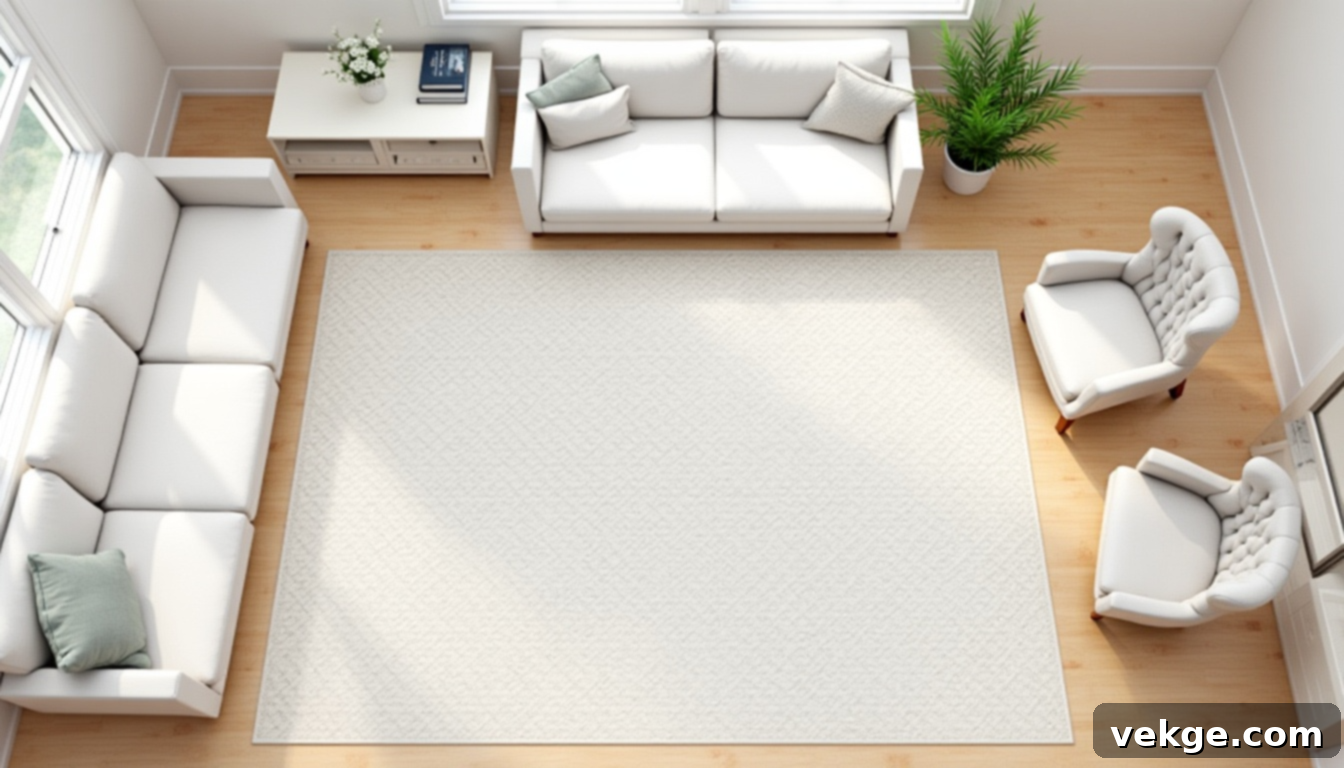The Ultimate Guide to Rug Sizes: Find the Perfect Fit for Every Room
Choosing the right rug can be a transformative experience for any space, instantly adding warmth, defining zones, and tying your decor together. However, finding the perfect rug size often feels like a puzzle, especially when you’re trying to match it with existing furniture and ensure it complements the dimensions of your room. A rug that’s too small can make your furniture look disconnected, while one that’s too large can overwhelm the space and make it feel cramped.
This comprehensive rug size guide is designed to take the guesswork out of your decision. We’ll walk you through everything you need to know, from understanding standard rug dimensions to specific recommendations for every room in your home. Whether you’re furnishing a cozy living room, a grand dining area, a tranquil bedroom, a bustling hallway, or even an outdoor patio, you’ll learn how to measure your room accurately, avoid common sizing mistakes, and select a rug that enhances your home’s style and functionality.
Ready to elevate your home decor and make your room feel more pulled together with the ideal rug size? Let’s dive in and discover the secrets to perfect rug placement!
How to Choose the Right Rug Size for Your Space
Selecting the correct rug size is more than just a stylistic choice; it significantly impacts the balance, comfort, and overall functionality of a room. A well-chosen rug can anchor furniture, define distinct areas within an open-plan layout, absorb sound, and provide a soft landing underfoot. Conversely, an ill-sized rug can make a room feel disjointed or even smaller than it is. Here’s a detailed approach to getting it right:
- Start by Measuring Your Room Accurately: Before you even begin browsing, grab a tape measure. Don’t rely on guesswork or estimates. Measure the full length and width of your room. Then, consider the specific area where you envision the rug. For example, in a living room, measure the perimeter of your main seating arrangement. This precise data will be your foundation for picking a rug that fits naturally without feeling too small or too bulky. A helpful trick is to use painter’s tape on the floor to outline your desired rug dimensions, helping you visualize the scale.
- Think About Your Furniture Layout and Function: The primary purpose of a rug is often to ground your furniture and create a cohesive zone. In living rooms, for instance, a rug should extend far enough to sit under at least the front legs of your sofa and accent chairs. This simple rule visually connects the pieces, creating an intimate and defined seating area. Without this connection, furniture can appear to float aimlessly in the room.
- Watch the Walkways and Clearances: Ensure your rug doesn’t impede natural traffic flow or block doorways. In open areas or rooms with multiple entry points, it’s generally recommended to leave 18–24 inches of visible floor space between the edge of the rug and the walls. This border helps the room breathe and prevents the rug from looking like wall-to-wall carpeting. Always check that doors can open and close freely over the rug, especially if you’re considering a thicker pile.
- Choose Based on How You Use the Room: The function of a room heavily influences the ideal rug size. A primary lounging space, like a family room, will benefit from a larger rug that provides maximum comfort and defines the entire conversational area. In contrast, smaller accent rugs might be perfect for defining a reading nook, brightening an entryway, or adding a soft touch in front of a kitchen sink. Consider the activities that will take place on or around the rug and choose accordingly.
What Are Standard Rug Sizes?
Rugs are typically manufactured in a range of standard sizes designed to fit most common room dimensions and furniture layouts. Understanding these sizes is crucial for making an informed decision. Here’s a breakdown of the most popular standard rug sizes and their ideal uses:
- 2×3 feet (approx. 24×36 inches / 61×91 cm): This petite size is excellent for small, high-traffic spots. Use it as a welcoming doormat in an entryway, a functional accent rug in a small bathroom, or in front of a kitchen sink for added comfort while washing dishes. It’s also perfect for layering over a larger rug to introduce texture or color.
- 3×5 feet (approx. 36×60 inches / 91×152 cm): A versatile size that offers a bit more coverage than a 2×3. It works well in smaller bedrooms at the foot of a twin bed, in reading nooks with an armchair, or as an accent rug to define a small area in a larger room. It can also be a good fit for a compact entryway or a medium-sized bathroom.
- 4×6 feet (approx. 48×72 inches / 122×183 cm): This size is a solid choice for small bedrooms (e.g., under a twin bed), cozy dining areas with a small table (2-4 chairs), or to anchor a small coffee table in a compact living room. It adds warmth without overwhelming tight spaces and can help create a defined zone.
- 5×8 feet (approx. 60×96 inches / 152×244 cm): Often referred to as the “apartment size” rug, a 5×8 is ideal for many living rooms, especially in smaller homes or apartments. It perfectly frames a coffee table and can accommodate the front legs of a sofa and a couple of chairs, helping to define your main seating area effectively. It also works well under the lower two-thirds of a full or queen bed.
- 6×9 feet (approx. 72×108 inches / 183×274 cm): A versatile size that fits well in larger bedrooms (under a queen bed with nightstands partially on it) or medium-sized living rooms. It provides ample space to anchor a full sofa and two accent chairs, creating a more substantial and cohesive gathering area. It’s also a good option for defining a dining space for a 4-6 seater table.
- 8×10 feet (approx. 96×120 inches / 244×305 cm): This size is a popular choice for spacious living rooms or under larger dining tables (6-8 chairs). In a living room, it helps anchor a full furniture grouping, allowing all front legs of a sofa, loveseat, and chairs to rest comfortably on the rug. In a dining room, it ensures all chair legs remain on the rug even when pulled out, facilitating easy movement.
- 9×12 feet (approx. 108×144 inches / 274×366 cm): Ideal for open floor plans, grand rooms, or very large living spaces with extensive furniture arrangements. A 9×12 rug fills big spaces, brings balance, and adds a polished, cohesive, and luxurious look. It can comfortably accommodate an entire living room suite or a large dining table with 8+ chairs.
- 10×14 feet and Larger: For truly expansive rooms or open-concept areas requiring multiple seating zones, even larger custom or oversized rugs (e.g., 10×14, 12×15) are available. These are perfect for grand living rooms, great rooms, or creating a cohesive feel in multi-functional spaces.
Rug Size Conversion Chart
This handy chart provides quick conversions between feet, inches, and centimeters for standard rug sizes, along with their most common applications. Use it as a quick reference to find the right rug size for your space and envision its ideal placement.
| Size (Feet) | Size (Inches) | Size (Centimeters) | Best Used For |
|---|---|---|---|
| 2×3 | 24×36 | 61×91 | Bathroom, kitchen, small entry, accent |
| 3×5 | 36×60 | 91×152 | Small bedroom, reading nook, small entryway |
| 4×6 | 48×72 | 122×183 | Medium bedroom, small dining, small living accent |
| 5×8 | 60×96 | 152×244 | Living room (small), large bedroom, under queen bed |
| 6×9 | 72×108 | 183×274 | Dining room (4-6 seats), living room (medium), under queen/king bed |
| 8×10 | 96×120 | 244×305 | Large living room, family room, dining room (6-8 seats) |
| 9×12 | 108×144 | 274×366 | Great room, open floor plan, large dining room (8+ seats) |
| 10×14 | 120×168 | 305×427 | Very large spaces, multiple seating zones |
Rug Size by Room Type: Tailoring Your Choice to Your Space
Different rooms within your home have unique requirements when it comes to rug sizing. The type of furniture, the room’s primary function, and its overall shape all play a critical role in determining the ideal rug dimensions. Let’s explore specific recommendations for each area:
1. Living Room Rug Sizes

In the living room, rugs are essential for bringing furniture together, defining the main seating area, and creating a sense of intimacy and cohesion. The size you choose here largely depends on your furniture arrangement and the overall room dimensions.
- Small Living Rooms (e.g., apartments, compact spaces): A 5×8 rug often works best. It’s perfectly sized to anchor a coffee table and allow the front legs of a sofa and perhaps one or two accent chairs to rest on it. This creates a cozy, defined zone without overwhelming the limited space. For very small setups, even a 4×6 can define a small conversational grouping of two armchairs and a small table.
- Medium Living Rooms (typical family rooms): Opt for 6×9 or 8×10 rugs. These sizes offer more versatility. An 8×10 rug allows you to place all front legs of a sofa, loveseat, and accent chairs on the rug, creating a more robust and unified grouping. It ensures the room feels balanced and comfortable, providing ample underfoot softness for the entire seating area.
- Large Living Rooms or Open Floor Plans: For expansive spaces, a 9×12 rug or even larger (e.g., 10×14) is usually necessary. These larger sizes are crucial for fully anchoring extensive furniture setups, such as a large sectional sofa, multiple armchairs, and side tables. They help to clearly define the living zone within a grand room or an open-concept layout, adding polish and preventing furniture from looking like it’s floating.
2. Dining Room Rug Sizes
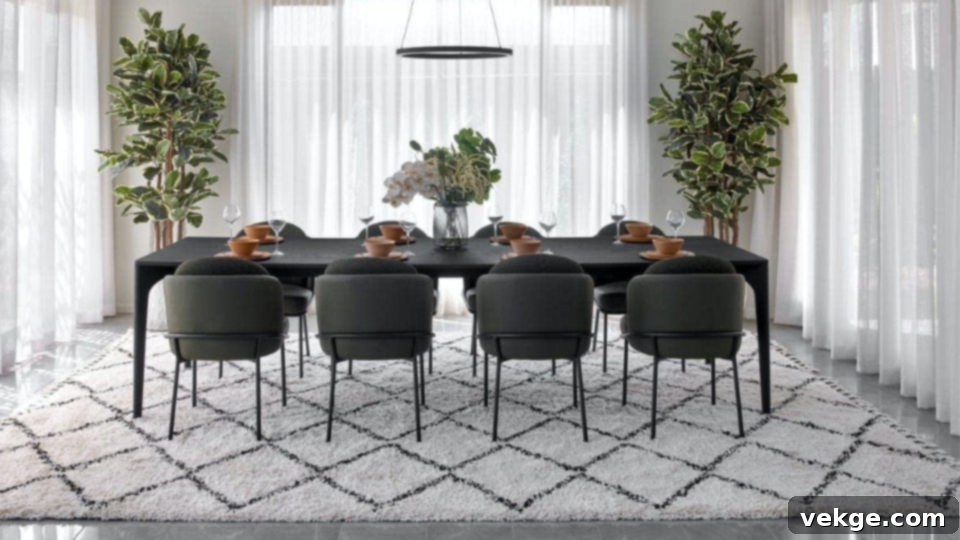
The cardinal rule for dining room rugs is that they must be large enough to accommodate all dining chairs, even when they are pulled out from the table for seating. This prevents chairs from catching on the rug’s edge and ensures smooth movement, providing a comfortable and functional dining experience.
- Rectangular Tables: As a general guideline, your rug should extend at least 24 inches (61 cm) beyond all sides of your dining table. This means adding approximately 4 feet (48 inches) to both the length and width of your table’s dimensions. For example, a 6×4 foot rectangular table would ideally need a rug that is at least 10×8 feet (6+4 ft length x 4+4 ft width) to keep all chairs fully on the rug when pulled out.
- Round Tables: Round tables pair beautifully with round rugs. To ensure proper coverage, choose a round rug that is at least 24-30 inches wider in diameter than your table. For instance, a 4-foot round table typically requires a 6-foot round rug as a minimum, but an 8-foot round rug will provide more generous coverage and a luxurious feel, ensuring chairs are comfortably positioned on the rug.
- Square Tables: Similar to rectangular tables, apply the 24-inch rule to all sides. A 4×4 foot square table needs at least an 8×8 foot square rug to allow for comfortable chair movement. If space allows, going slightly larger can create an even more proportional and polished look.
3. Bedroom Rug Sizes
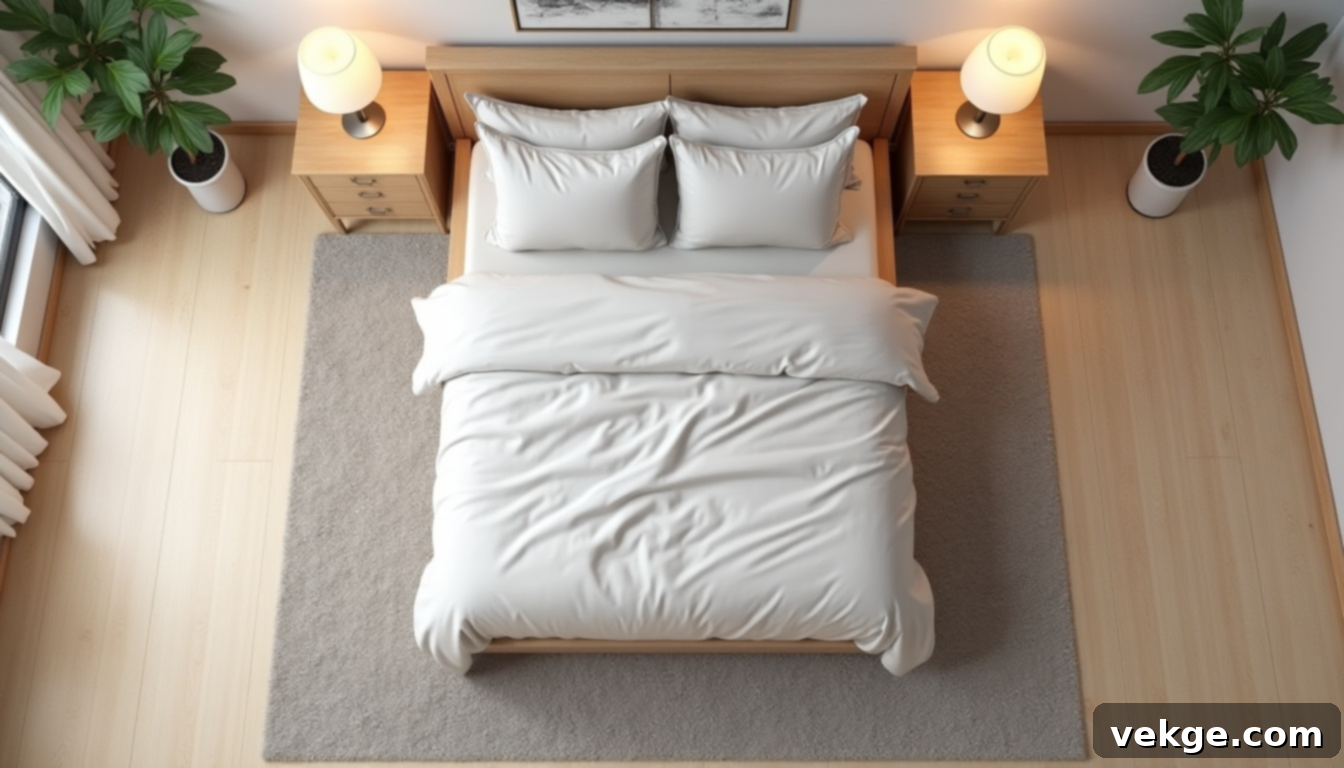
Bedroom rugs are all about comfort, warmth, and defining the sleeping area. They can be placed in several ways: primarily under the bed, positioned in front of the bed, or as smaller accent rugs on either side. The desired placement will dictate the size you need.
- Twin Beds: A 4×6 or 5×8 rug works well, placed under the lower two-thirds of the bed. This allows for soft cushioning underfoot when you get in and out of bed, extending beyond the sides and at the foot for added comfort and visual balance.
- Queen Beds: For a queen bed, a 6×9 rug is a popular choice, typically placed under the bottom half to two-thirds of the bed. This leaves ample space on the sides and at the foot of the bed. For more expansive coverage and a truly luxurious, anchored feel, an 8×10 rug is ideal, allowing the bed, and often the nightstands, to sit fully on the rug.
- King Beds: To fully anchor a king-sized bed and its accompanying nightstands, a 9×12 rug is the recommended choice. This size provides generous coverage on all sides, creating a plush island around the bed. If a 9×12 is outside your budget or doesn’t fit your room, consider alternative layouts such as a 6×9 area rug placed horizontally at the foot of the bed, or two 3×5 area rugs placed on either side of the bed for bedside comfort.
4. Entryway and Hallway Runner Sizes
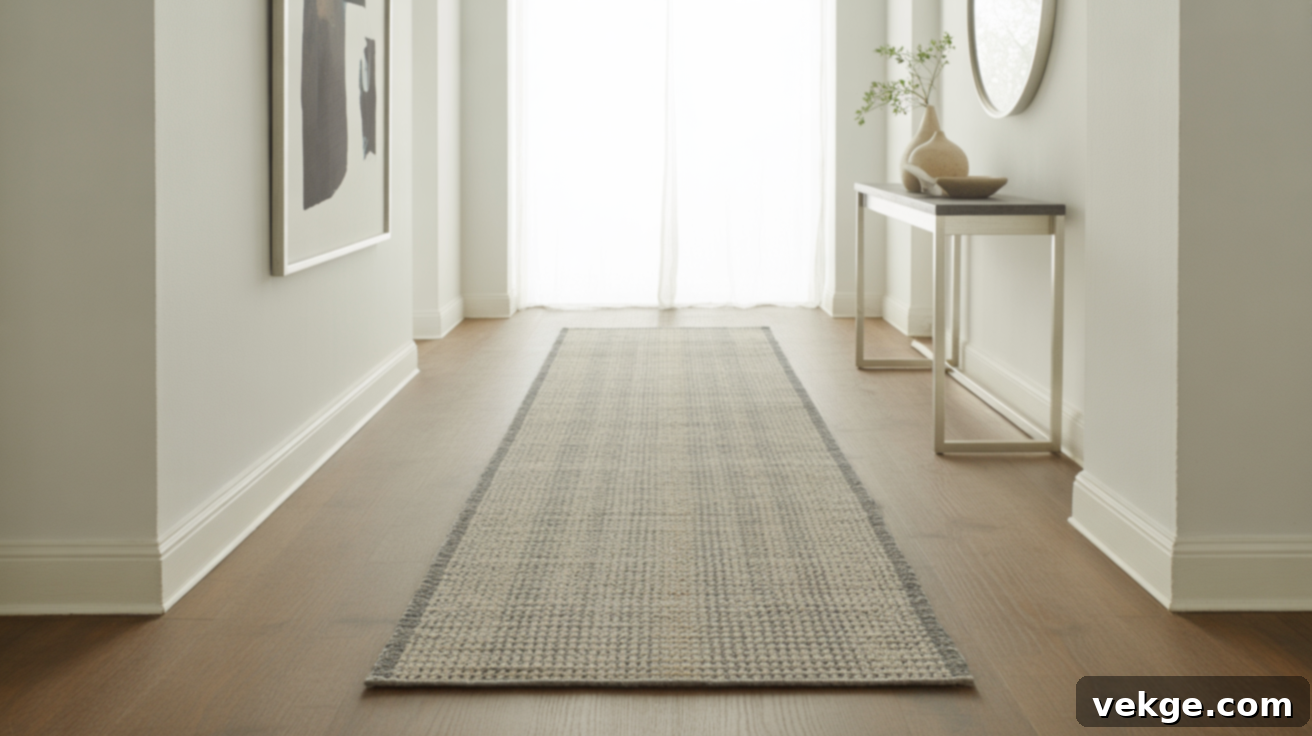
Entryways and hallways are high-traffic zones that benefit greatly from rugs, which protect floors, trap dirt and moisture, and add a welcoming touch. The size and shape of these rugs depend on the dimensions of your space and the type of doors you have.
- Small Entryways or Foyers: For compact entryways, a 2×3 or 3×5 rug is generally sufficient. These sizes provide a designated spot for removing shoes, help protect your floors from outside elements, and introduce a stylistic element right at the door. Always ensure the rug allows ample clearance for the door to open fully without catching.
- Large Entryways: If you have a more spacious entryway, a 4×6 or 5×8 rug can effectively define the area, especially if you have a console table or a bench. These larger sizes offer greater floor protection and make a more impactful design statement, enhancing the overall welcoming feel.
- Hallways: Hallway runners are specifically designed for narrow, elongated spaces. When choosing a runner, aim to leave 6–9 inches of visible flooring at each end of the hallway for a balanced look. Standard runner widths typically range from 2–3 feet, and their lengths should be chosen to fit your hallway, usually leaving approximately 12–18 inches of floor space on both sides for visual framing. Avoid runners that are too long, as they can make the hallway feel cramped, or too short, which can make it appear disconnected.
5. Kitchen and Bathroom Rug Sizing Tips
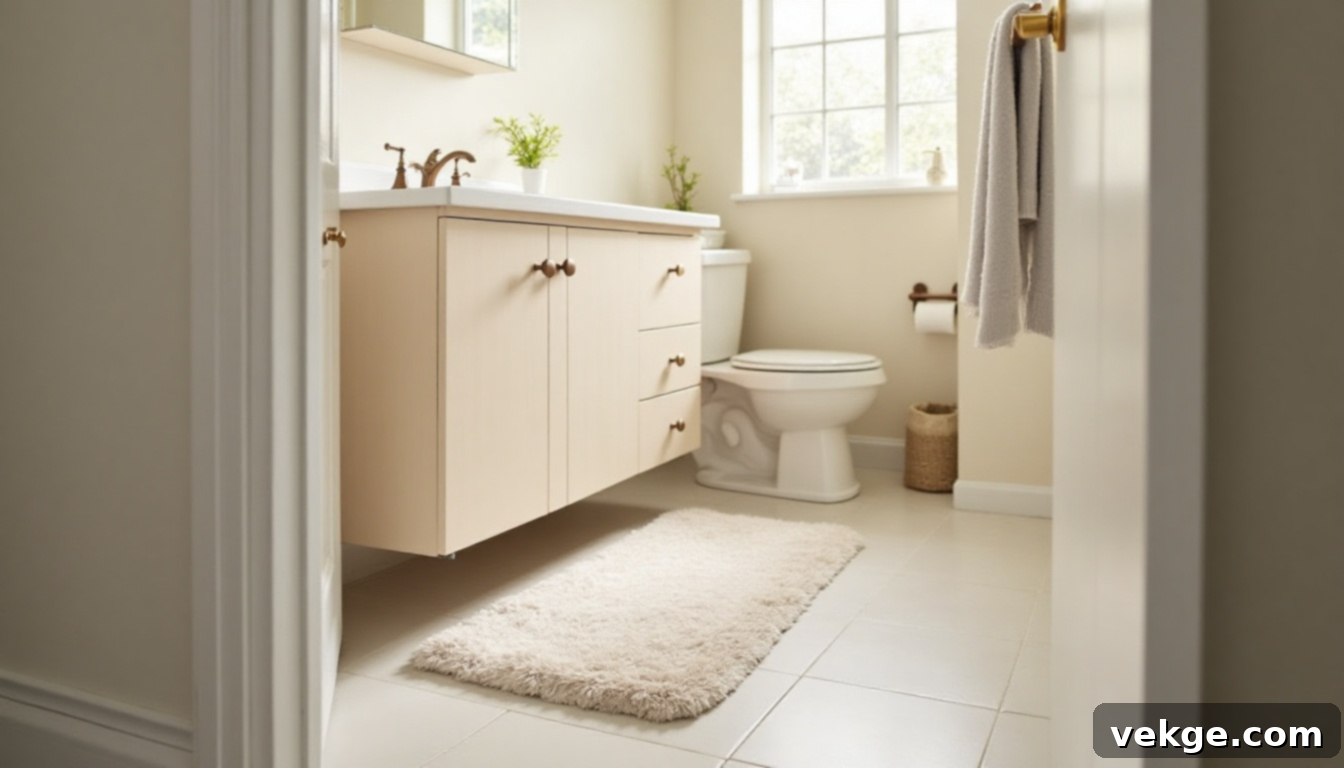
Rugs in kitchens and bathrooms serve both practical and aesthetic purposes, adding comfort, absorbing spills, and enhancing the decor. In these moisture-prone and high-activity areas, proper fit, material choice, and safety are paramount.
- Kitchen Rugs: For targeted comfort and spill protection, use 2×3 rugs in front of sinks or stoves. In galley kitchens or alongside islands, 2×6 runners are excellent for providing cushioning along the main work path. Larger kitchens can accommodate 3×5 rugs to define a specific zone, such as a breakfast nook, without obstructing critical traffic flow. Consider anti-fatigue mats for areas where you stand for extended periods.
- Bathroom Rugs: A standard 2×3 rug is suitable for most bathrooms, fitting perfectly near vanities, showers, or tubs. For small powder rooms, a compact 20×30 inch mat might be all that’s needed. In larger master bathrooms, you can incorporate 3×5 rugs or even runners to add luxury and warmth, especially in front of double vanities or alongside large walk-in showers.
- Moisture-Friendly and Safe Materials: More than size, the material is critical here. Look for rugs made from cotton, bamboo, or synthetic materials like polypropylene. These materials are naturally more water-resistant, dry quickly, and handle humidity better than wool or silk rugs. Always prioritize rugs with non-slip backings in both kitchens and bathrooms to prevent accidents on potentially wet or slippery floors.
6. Outdoor Rug Sizes for Patios and Decks
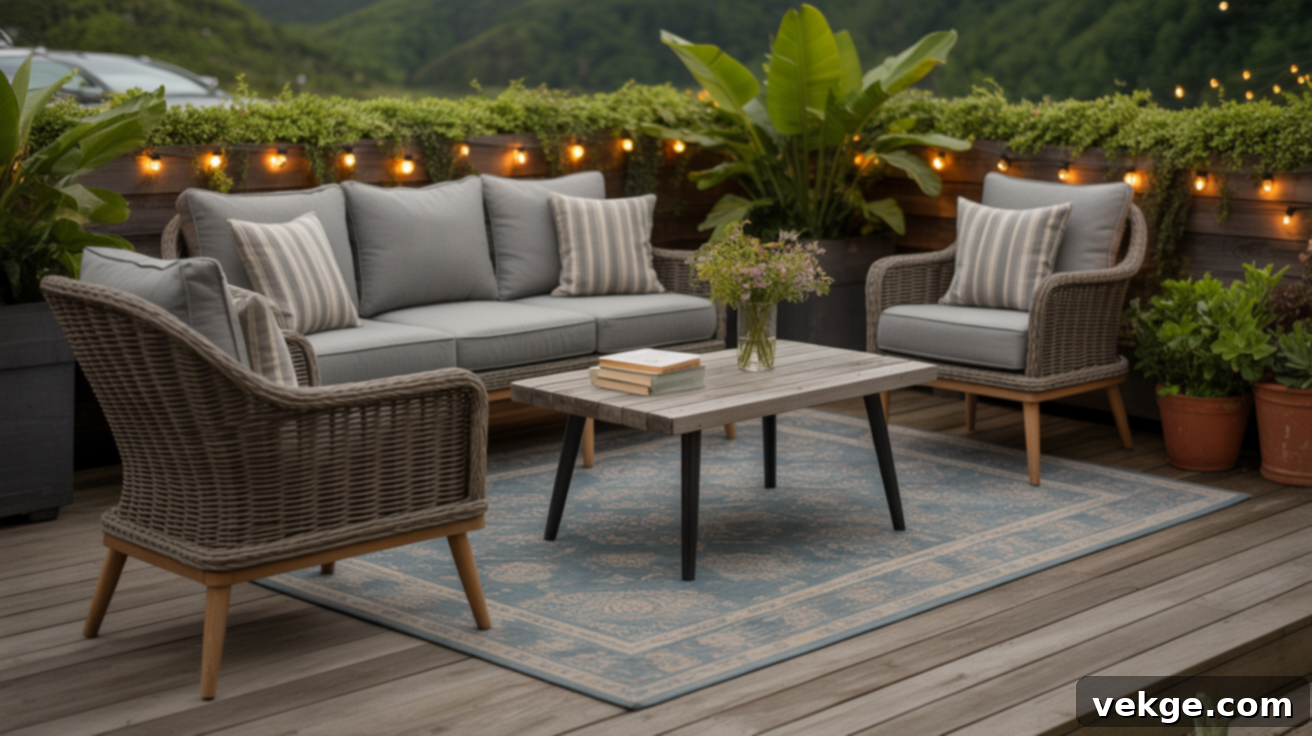
Outdoor rugs are fantastic for extending your living space, defining seating or dining areas on patios and decks, and adding comfort to hard surfaces. They must be durable enough to withstand the elements while offering the same grounding and aesthetic benefits as indoor rugs.
- Small Patios & Balconies: For compact outdoor areas with a bistro table or a couple of lounge chairs, a 4×6 or 5×8 outdoor rug is typically sufficient. These sizes help to visually organize and bring comfort to smaller outdoor layouts, making them feel more like an extension of your home.
- Large Patios & Decks: For more expansive outdoor spaces that feature full dining sets or a generous lounge area, 8×10 or 9×12 outdoor rugs are ideal. These larger sizes effectively create a finished “outdoor room” feel, anchoring all your furniture and providing significant underfoot comfort. They help delineate different zones within a large patio, such as a dining zone and a separate seating area.
- Furniture Placement Outdoors: Just as with indoor rugs, ensure that at least the front legs of your outdoor furniture (or ideally, all legs) rest fully on the rug. This not only prevents wobbling but also gives your patio a more cohesive, intentional, and polished look, truly making it feel like an outdoor living space. Always choose outdoor-specific rugs made from weather-resistant materials like polypropylene, jute, or sisal blends to ensure longevity and easy maintenance.
Rug Placement Rules That Work with Furniture
Beyond simply choosing the right size, how you position your rug in relation to your furniture can drastically affect the room’s feel. Following these proven rug placement rules will ensure your space looks cohesive, intentional, and professionally styled:
1. The “Front Legs On” Rule
This is arguably the most common and versatile rug placement method for living rooms. The rug is placed under the front legs of your sofa and any accent chairs within the main seating arrangement. This approach effectively anchors the seating area visually, creating a defined zone for conversation and relaxation. It works well in most room sizes, as it connects furniture without covering too much of your flooring, allowing it to act as a frame.
2. The “All Legs On” Rule
In this setup, every piece of furniture within a specific grouping—including sofas, chairs, coffee tables, and side tables—sits entirely on the rug. This method creates a grand, unified, and luxurious look. It’s particularly effective in larger rooms or open-concept spaces where you want to clearly define an expansive area. The “all legs on” rule makes a room feel more substantial and cohesive, as the rug acts as a true foundation for the entire furniture arrangement.
3. The “All Legs Off” Rule
This approach means the rug is placed completely in front of all furniture, without touching any legs. The “all legs off” rule works best for accent rugs, very small rooms, or when using a rug that is deliberately smaller for a specific decorative purpose (e.g., a sheepskin rug next to an armchair). While it can work, it requires careful consideration to avoid the rug looking like it’s floating or disconnected from the furniture. Ensure the rug is still substantial enough to visually ground the space it’s trying to define.
4. The “18-Inch Wall Clearance” Rule
For most rooms, aim to leave approximately 18 to 24 inches of visible bare floor space between the edges of the rug and the walls. This creates a natural border that allows your flooring to frame the rug beautifully, preventing the rug from looking like an ill-fitting carpet. This visual breathing room helps the rug feel well-proportioned and prevents it from overpowering the room, making the space feel larger and more open.
Following these simple rug placement rules can instantly improve your room’s appearance and feel. Whether you’re styling a small, intimate space or a large, expansive living area, the right rug layout brings everything together with comfort, clarity, and undeniable style.
Common Mistakes to Avoid When Choosing a Rug
Even the most beautiful rug won’t achieve its full potential if the size or placement is incorrect. Being aware of these common pitfalls will help you make a smarter choice and ensure your rug truly enhances your home:
- Choosing a Rug That’s Too Small: This is arguably the most frequent mistake. A rug that’s too small makes furniture look like it’s floating in the middle of the room, creating a disconnected and unbalanced feel. It often resembles a “postage stamp” in the center of the room, failing to anchor any furniture. When in doubt, it’s almost always better to size up; a slightly larger rug makes a room feel more expansive and cohesive.
- Ignoring Furniture Scale and Room Proportion: A tiny rug placed under a massive sectional sofa will look completely out of proportion, making both the rug and the sofa appear awkward. Similarly, a massive rug jammed into a tiny room can make the space feel cramped and overwhelmed, resembling wall-to-wall carpeting rather than a distinct area rug. Always consider the overall scale of your furniture and the dimensions of your room to ensure a harmonious balance.
- Overlooking Room Function and Traffic Flow: A rug should complement your lifestyle and the room’s purpose. Placing a thick, high-pile rug in a dining room, for instance, can make it difficult to slide chairs in and out. A rug that obstructs natural walkways or blocks a doorway is not only inconvenient but also a tripping hazard. Always visualize how people will move through the space and how the rug will integrate with daily use.
- Forgetting About Rug Thickness (Pile Height): The thickness of a rug’s pile can have practical implications. A very thick, shaggy rug might be luxurious underfoot in a bedroom but could block doors from opening or make dining chairs unstable. Always measure door clearances if placing a rug near an entryway, and consider the stability of furniture legs on a high-pile surface.
- Neglecting Material Suitability for the Room: While not strictly about size, choosing the wrong material can quickly render a rug ineffective. A delicate silk rug might look beautiful but won’t last long in a high-traffic hallway or a kitchen prone to spills. Conversely, a rough jute rug might not be ideal for a cozy bedroom where you seek softness. Match the rug’s material and durability to the demands of its intended room.
Avoiding these common mistakes will ensure your rug doesn’t just fill space, but actively contributes to the comfort, style, and functionality of your entire room. With the right size, fit, and material, your rug will truly bring the whole room together.
Conclusion
Choosing the right rug size doesn’t have to feel confusing or overwhelming. By understanding the core principles of measurement, furniture placement, and room function, you are now equipped with the knowledge to make confident and informed decisions for every space in your home. From the cozy confines of a small bedroom to the expansive layout of an open-concept living area, the perfect rug awaits.
Just remember these key takeaways: always measure your space and furniture first, visualize the rug’s footprint (perhaps with painter’s tape), and avoid the common sizing mistakes that can disrupt a room’s balance. When in doubt, it’s often better to go up a size to ensure your rug properly anchors your furniture and defines your living zones.
A well-chosen rug is more than just a floor covering; it’s an essential design element that adds warmth, texture, and personality, transforming a house into a home. Take these tips, apply them to your space, and watch as your rooms feel more cohesive, comfortable, and beautifully pulled together.
Want more help making your home feel just right? Check out our other blogs for simple tips, room-by-room guides, and style ideas that work in real life to inspire your next home decor project!
Frequently Asked Questions About Rug Sizes
Can I use a 5×7 rug in the dining room?
While a 5×7 rug can technically fit under a very small, perhaps two-person bistro-style dining table, it’s generally considered too small for a standard dining room setup with 4-6 chairs. The critical rule for dining room rugs is that all chair legs must remain on the rug even when pulled out from the table. A 5×7 rug typically won’t allow for the necessary 24 inches of clearance around all sides of a standard dining table, leading to chairs catching on the rug’s edge and creating an uncomfortable dining experience. For most dining tables, you’ll need at least an 8×10 or 9×12 rug.
What size rug fits under a queen bed?
For a queen bed, you have a couple of excellent options depending on the coverage you desire. A 6×9 rug is a popular choice, typically placed under the lower two-thirds of the bed, extending out on the sides and foot. This provides a soft landing underfoot when you step out of bed. For more expansive coverage and a luxurious, anchored feel, an 8×10 rug is ideal, allowing the bed, and often the nightstands, to sit fully on the rug. Alternatively, for accents or smaller budgets, you could use two 3×5 rugs on either side of the bed or a 5×8 rug placed horizontally at the foot of the bed.
What does “rug pile” mean?
Rug pile refers to the height and density of the fibers or loops that make up the surface of the rug. It significantly impacts the rug’s texture, durability, and appearance.
- Low Pile: Characterized by short, dense fibers, low-pile rugs are durable, easy to clean, and less prone to showing footprints. They are ideal for high-traffic areas like entryways, dining rooms (where chairs need to slide easily), and under furniture. They also tend to have a more contemporary or sleek look.
- High Pile: Featuring longer, looser fibers (like shaggy or shag rugs), high-pile rugs feel plush, soft, and luxurious underfoot. They excel in bedrooms and living rooms where comfort and warmth are priorities, and they also offer excellent sound-dampening qualities. However, high-pile rugs require more upkeep (prone to shedding and trapping dirt) and can be challenging for furniture placement or door clearances.
Should my rug go under the couch or in front of it?
To create a cohesive and anchored look, it’s generally best for your rug to go under the couch, specifically with at least the front legs of the couch resting on the rug. This method visually connects the sofa to the rug, defining the seating area and making the room feel more intentional and balanced. If your rug is too small to extend under the front legs, placing it completely in front of the couch without touching it is a secondary option. However, avoid placing a rug that only partially covers the front of the sofa, as this can make the furniture look disconnected and the rug appear to be floating awkwardly in the middle of the room.
